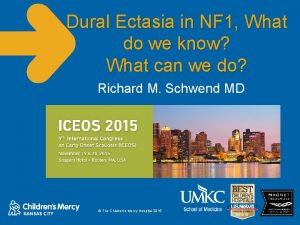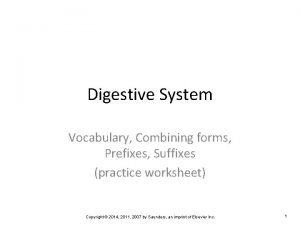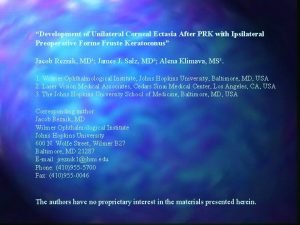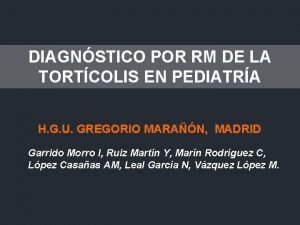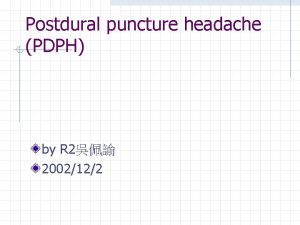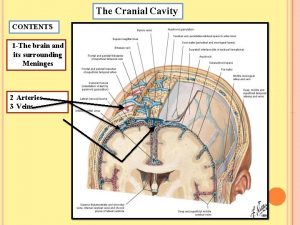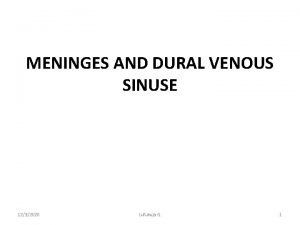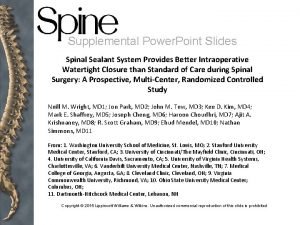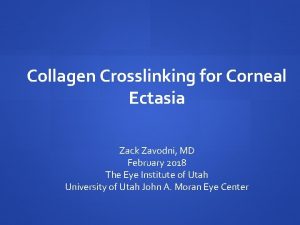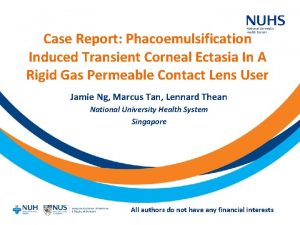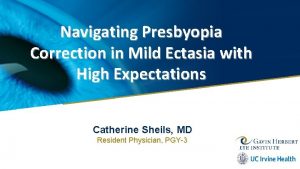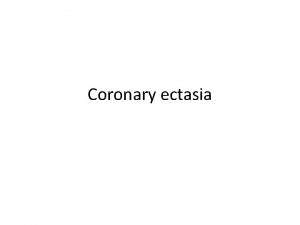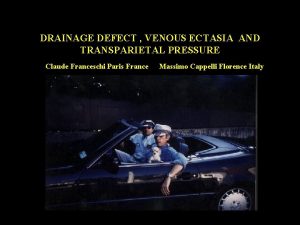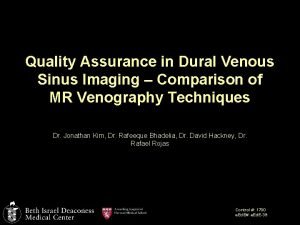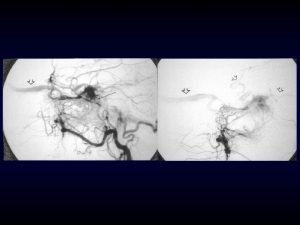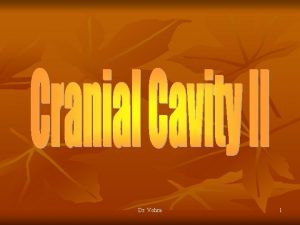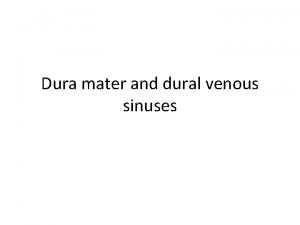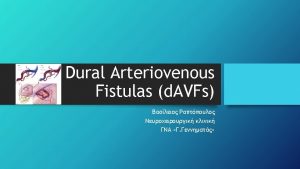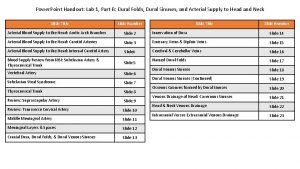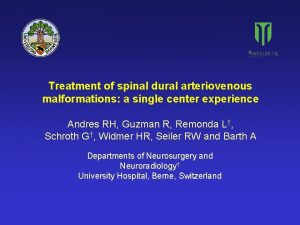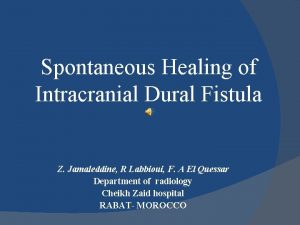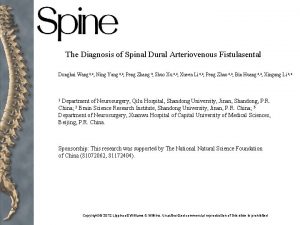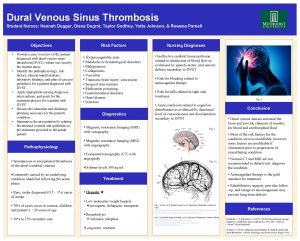Dural Ectasia in NF 1 What do we






























- Slides: 30

Dural Ectasia in NF 1, What do we know? What can we do? Richard M. Schwend MD © The Children's Mercy Hospital 2015 1

Disclosures • None related to this talk 2

What Do We Know? • Dural ectasia is circumferential enlargement, widening or ballooning of the dural sac, nerve root sleeves and spinal canal. • Can affect the spinal canal in any plane. • All spine locations, but common in lumbosacral region 3

Associated Conditions • Marfan syndrome • Loeys Dietz syndrome • Developmental spondylolisthesis • NF 1 • Ehlers-Danlos syndrome • Achondroplasia • Vertebral fractures • Ankylosing spondylitis • Osteogenesis imperfecta • Post surgical • Idiopathic 4

Associated Conditions • Marfan syndrome • Loeys Dietz syndrome • Developmental spondylolisthesis • NF 1 • Ehlers-Danlos syndrome • Achondroplasia • Vertebral fractures • Ankylosing spondylitis • Osteogenesis imperfecta • Post surgical • Idiopathic 5

Associated Conditions • Marfan syndrome • Loeys Dietz syndrome • Developmental spondylolisthesis • NF 1 • Ehlers-Danlos syndrome • Achondroplasia • Vertebral fractures • Ankylosing spondylitis • Osteogenesis imperfecta • Post surgical • Idiopathic 6

Associated Conditions • Marfan syndrome • Loeys Dietz syndrome • Developmental spondylolisthesis • NF 1 • Ehlers-Danlos syndrome • Achondroplasia • Vertebral fractures • Ankylosing spondylitis • Osteogenesis imperfecta • Post surgical • Idiopathic 7

Marfan Syndrome • Less common than NF 1 1/5000 • Deficiencies in fibrillin-1 increase the levels of B(TGF-B) leading to Marfan phenotype • Sponseller 2013 • Dural ectasia -one of the major (modified Ghent) diagnostic criteria. • Rose PS 2000 • Often in lumbosacral spine, thinning of bone, anterior meningocels, LBP. • Over 63% prevalence of dural ectasia, peaks in adolescence • Mesfin 2013 8



Dural Ectasia. Radiographic Critera • Plain radiographs • Scalloping (92% specific but only 57% sensitive • Ahn 2001 • Major: Width dural sac below L 5 > width above L 4, anterior sacral meningocel. Minor: L 5 nerve root sleave diameter >6. 5 mm. S 1 scalloping >3. 5 mm • Ahn 2000 11

MRI for Dural Ectasia Children • Only dural sac ratio at L 5 and S 1 and sagittal dural sac width at S 1 greater than L 4 significant for dural ectasia • Habermann CR 2005 12

13 an d Ma rke tin g. • Grading system of Fattori for Marfan Lancet 1999

Neurofibromatosis • Autosomal dominant • Deletion of the NF 1 gene on chromosome 17 q 11. 2 • 1/3000 -4000 globally • 50% de novo mutations • Varied presentation and penetrance. • Diagnosis based on clinical findings >=2/7 NIH diagnostic criteria 14



17

Tissue Defects in NF 1 • NF 1 - potent tumor suppressor gene. • NF 1 gene encodes for protein neurofibromin, expressed in many cells/tissues • Genetically modified mouse models and NF 1 patient cells • Deficiency in osteoblast differentiation/commitment • Increase in osteoclast differentiation/survival • NF 1 haploinsuficiency or double inactivation of NF 1 gene in range of cells: osteoblasts, chondrocytes, fibroblasts, vascular endothelia –defective bone healing – Schindeler A, Little DG 2008 • 18

Cellular basis for osseous defect formation and recalcitrant repair Schindeler A and Little DG, 2008 19

What does NF 1 Do? • Required for proper endochondral ossification • Intervertebral disc formation • Proper axial skeleton formation • Bone remodeling and skeletal properties – Wang W 2001 20

NF 1 and Osteoprogenitor • Lack of Nf 1 Col 2 -/- in osteochondroprogenitor cells in mice show progressive spine deformity • Low bone mass phenotype • Wang W, 2011 21

22

Pathophysiology of Dural Ectasia NF 1 • General primary mesodermal dysplasia • Weakness in the collagen through proliferation and invasion of NF 1 deficient fibroblasts • Atit 1999 • 30% have osteopenia due to haploinsufficiency • Osteomalacia, osteoporosis, vitamin D deficiency, stress fracture • CSF pulsations 23

Progressive NF 1 Scoliosis August 12, 2013

August 12, 2013


27

NF 1 and Dural Ectasia • Frequently thoracic • Can be relatively protective, increased SAC • Posterior scalloping commonly associated with dural ectasia • Lateral and anterior scalloping commonly result of primary mesodermal dysplasia • Tsirikos AI 2004 • Anterior dural ectasia and dislocation of the spine • Winter 1991 28

Modi HN 2009 De Kleuver M 2004 29

What Can We Do? • Only case series and case reports. • Stick to sound principles • Preserve growth/prevent deformity • Avoid the dural ectasia and tumors • Anterior- posterior fusion • Be aware of ribs in the canal • sharp curves/relative stenosis • Therapies • BMP/Bisphophonates • Mouse model – (RAS/ERK pathway activation by Nf 1 loss of function) 30
